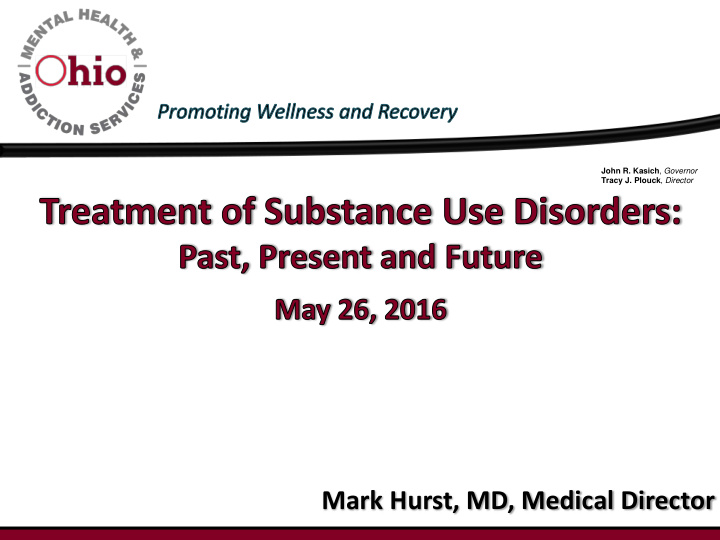



John R. Kasich , Governor Tracy J. Plouck , Director Mark Hurst, MD, Medical Director
2
John R. Kasich , Governor Tracy J. Plouck , Director
Cocaine Methamphetamine Alcohol Heroin
11
Addiction is not merely about the USE of a substance, it is about the brain’s response to that use and subsequent behaviors resulting from the brain’s response
• Addiction is a primary , chronic disease of brain reward , motivation, memory and related circuitry. Dysfunction in these circuits leads to characteristic biological, psychological, social and spiritual manifestations. This is reflected in an individual pathologically pursuing reward and/or relief by substance use and other behaviors.
Addiction is characterized by: Inability to consistently Abstain ; • Impairment in Behavioral control; • Craving ; or increased “hunger” for drugs or • rewarding experiences; Diminished recognition of significant • problems with one’s behaviors and interpersonal relationships; and A dysfunctional Emotional response. •
15
Genetics • Environment and life experiences • Exposure to potentially addictive substances (especially • early in life) Early life trauma • Life stress • Other Predisposing conditions • Mental Illness • All influence the brain’s response to substances and the likelihood of developing a substance use disorder
Disordered functioning of a part of the body • for one or more causes (etiology) Continues over a long period or recurs • Characteristic symptoms • Characteristic signs • Predictable course • Known outcomes • Treatments •
Disease Cardiac Disease Addiction characteristic Symptoms Weakness Craving • • Shortness of breath on Inability to control use • • exertion Consequences of use • Chest pain • Signs EKG abnormalities Abnormal lab tests, • • Abnormal stress test Infections • • Abnormal angiography Accidents, etc. • •
Factor Cardiac Disease Addiction Genetics Substantial genetic Substantial genetic • • component component Life experiences Early life trauma Early life trauma • • Stress Stress • • Sedentary lifestyle Drug exposure • • Predisposing conditions Addiction Mental illness • • esp. tobacco • Hypertension • Diabetes •
Outcome Cardiac Disease Addiction Untreated Progressive Progressive • • deterioration in deterioration in functioning and functioning and premature death premature death Treated Most survive and do Most survive and do • • well, but despite well, but despite treatment may have treatment may have exacerbations of exacerbations of symptoms symptoms
Type of Cardiac Disease Addiction treatment “Old” (acute Patient has heart attack Patient has addiction related crisis • • care) Treated in hospital “Minnesota Model” • • Sometimes lives Fixed length treatment • • Discharged to home with no Accelerated 12-step program • • further treatment Discharged to home with AA • Return of symptoms: go back to follow-up • hospital Return of symptoms: go back to • treatment “New” (chronic Patient has heart attack Patient has addiction related crisis • • care) Revascularization Assessment determines type and • • Usually lives intensity of care • Cardiac rehab, diet changes, stop Counselling, 12-step therapy • • smoking, etc. Medications to prevent relapse • Medications to prevent relapse Return of symptoms: increase • • Return of symptoms: increase intensity of treatment • intensity of treatment
100 Percent of Patients Who Relapse 90 80 70 60 50 40 50 to 70% 50 to 70% 40 to 60% 30 to 50% 30 20 10 0 Type I Hypertension Asthma Drug Diabetes Addiction 23 McLellan et al., JAMA, 2000.
• ASAM Criteria for Treatment of Addictive, Substance-Related, and Co-Occurring Conditions (2013) • Developed by American Society of Addiction Medicine in collaboration with clinical experts, researchers and stakeholders 3 rd edition: 1 st edition based in large part on “Cleveland • Criteria” (1992)
• Guidelines for: • Assessment • Service planning • Placement • Continued stay • Discharge • Multidimensional patient assessment Intensity of Service Severity of Illness
1. Acute Intoxication or Withdrawal Potential 2. Biomedical conditions and complications 3. Emotional/behavioral/cognitive conditions and complications 4. Readiness to change 5. Relapse/continued use/continued problem potential 6. Recovery environment
• Level 0.5: Early Intervention • Level I: Outpatient Treatment • Level II: Intensive Outpatient/Partial Hospitalization • Level III: Residential/Inpatient Treatment • Level IV: Medically-Managed Intensive Inpatient Treatment
Multidimensional Assessment Progress in Severity of Treatment Illness/Problems Location and Intensity of Service
• Individualized based on unique patient needs • Discourages “one size fits all” programs of fixed content and duration • Matches treatment to nature of the disease: chronic disease requires flexible approach based on activity of and severity of disease at any point • Encourages treatment as a continuous care strategy • Discourages treating chronic disease with: • Longer episodes of existing treatments or • Succession of acute care episodes
Intervention Cardiac Disease Addiction • • Prevention Know family history Know family history • • Don’t smoke Delay/eliminate exposure to • Exercise drugs that can cause addiction • • Follow a prudent diet Stress management • • Stress management Decrease early life trauma • • Decrease early life trauma “Start Talking” and other interventions • • Early Treat Diabetes, hypertension, Identify and treat mental intervention elevated lipids illness • • Smoking cessation, exercise, SBIRT • • Treatment Utilize modern evidence-based Utilize modern evidence-based approaches for treatment approaches for treatment • • Life-saving CPR Wide availability of naloxone • measures Wide availability of and individuals trained to defibrillators administer
In Treating Addiction… We Need to Keep Our Eye on the Real Targets! 32
After 5 years – if you are sober, you probably will stay that way . It takes a year of abstinence before less than half relapse 33 Dennis et al, Eval Rev, 2007
• Over a million Ohioans are currently or have previously experienced a substance use disorder • Addiction is a chronic, bio-behavioral disease that requires chronic bio-behavioral treatment • Treatment success requires addressing the biological, and social aspects of the disease in a comprehensive manner and generally require both non-medication and medication treatments • Recovery is not only possible, it is likely in motivated patients receiving appropriate and consistent treatment
Recommend
More recommend